 Such a problem as a tooth fracture, requires a comprehensive approach, so the qualitative diagnosis of pathology, its effective treatment are possible only with the participation of a specialist.
Such a problem as a tooth fracture, requires a comprehensive approach, so the qualitative diagnosis of pathology, its effective treatment are possible only with the participation of a specialist.
To properly assign a therapy regimen, it is important to fully understand the causes.
Contents
- Why do teeth fall apart in an adult?
- Causes of tooth decay in a child
- What measures need to be taken?
- How to restore the tooth
- When a crack appears on the tooth enamel
- When the enamel crumbles
- If the tooth crumbles and the root remains alive
Why do teeth fall apart in an adult?
The following are the main reasons for tooth decay in adults:
- Teeth injury as a result of a hard object or impact. If the consequence is a chipped tooth and a violation of its integrity, crumbling is difficult to stop.
-
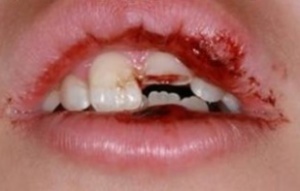 Incorrect dental therapy ( poor-quality caries treatment or improper installation of a seal).
Incorrect dental therapy ( poor-quality caries treatment or improper installation of a seal). - Decrease in strength of enamel with age , triggering the mechanisms of its decay.
- Pregnancy period due to weakening of the bone system due to lack of calcium( demineralization of teeth).
- Metabolic disorders with the development of fermentopathy, inflammation of the intestines, resulting in a change in the composition of saliva, it ceases to feed the teeth with calcium and disinfect them. Acquired sour taste of saliva corrodes the enamel, making it porous. The same processes are observed in the bone tissue of the body as a whole.
-
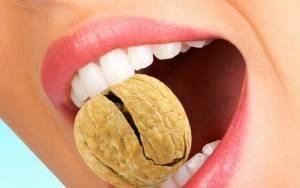 Inadequate hygiene of and formation of bone tissue destroying caries. Especially dangerous are hidden from the eyes inflammatory processes in closed fissures and located at the base of the teeth slits( cervical caries).
Inadequate hygiene of and formation of bone tissue destroying caries. Especially dangerous are hidden from the eyes inflammatory processes in closed fissures and located at the base of the teeth slits( cervical caries). - Shortage in the body of vitamin D .
- Allergic, autoimmune or endocrine disorders of , including arthritis, diabetes.
- Bad heredity of .
- Bite abnormality with an incorrect distribution of the masticatory load.
- Harmful habits of ( gnawing solid objects), which cause the appearance of cracks on the enamel.
Causes of tooth decay in a child
Crumbling of dental teeth is especially dangerous because of the risk of incorrect development of permanent teeth. Destruction may be caused by:
- lack of during the intrauterine development of fluoride, calcium and iodine , without which it is impossible to fully form the teeth in the child - often important elements do not come to the developing fetus due to unbalanced nutrition of the mother, preventing the absorption of necessary substances of strong toxemiaor failure of the placenta to perform its functions;
-
 reception during pregnancy of antibiotics of group tetracyclines , strong antiviral preparations, in particular, tetracycline leads to darkening of enamel still not cut teeth, therefore fluorosis appears immediately with their appearance;
reception during pregnancy of antibiotics of group tetracyclines , strong antiviral preparations, in particular, tetracycline leads to darkening of enamel still not cut teeth, therefore fluorosis appears immediately with their appearance; - hereditary nature of the pathology ;
- by artificial feeding with regular night feeding after a year with a sweet mixture that causes "bottle" caries and chopping small teeth;
- lack of oral hygiene , the inability of the baby to brush his teeth;
- with a long sucking on a dummy , which results in a malocclusion;
- deficient immunity of .
What measures need to be taken?
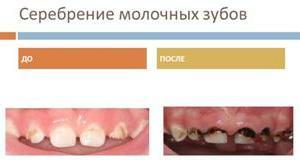 Even barely noticeable tooth decay is a serious reason to call a doctor.
Even barely noticeable tooth decay is a serious reason to call a doctor.
In childhood, inhibiting the destruction of tooth enamel helps seal the fissures of , their silvering or the application of a protective lacquer coating on the enamel. Also, rinse using herbal infusions is prescribed.
Simultaneously with local treatment for both small and adult patients, care must be taken to ensure hygiene and proper nutrition.
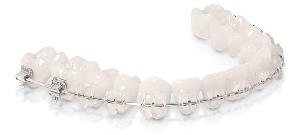 If the teeth are actively shedding, the dentist can perform the following procedures:
If the teeth are actively shedding, the dentist can perform the following procedures:
- restoring the damaged areas by sealing;
- drill out existing carious cavities and restore the shape of the tooth;
- restoration of the broken bite through the installation of braces or kappas( orthodontic treatment).
It is the dentist who must choose the dentifrices that will give the maximum effect( often recommended are soft, not injuring an already weakened enamel, brushes, pastes with fluoride and calcium).
Methods for restoration of the tooth
Features of the restoration procedures depend on the degree of damage to the enamel.
If a crack appears on the tooth enamel of
If the enamel cracked on the front tooth, a good result is given by special strengthening and healing procedures, the kind of which is determined by the depth of the cracks.
The most effective:
-
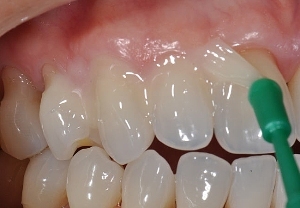 Remineralization. Promotes strengthening of the top layer of tooth enamel, its enrichment with useful substances, among which calcium, phosphorus and fluorine are of particular importance. For the procedure, a soft gel is used, which does not cause uncomfortable sensations.
Remineralization. Promotes strengthening of the top layer of tooth enamel, its enrichment with useful substances, among which calcium, phosphorus and fluorine are of particular importance. For the procedure, a soft gel is used, which does not cause uncomfortable sensations. - Filling a crack with a composite material. It is used after the end of remineralization. Most often, the procedure is carried out using a light curing lacquer, for fixing which on the surface of the tooth, the radiation from a special medical lamp is used. A feature of dental lacquer is the presence in its composition of health-improving and strengthening components. This tool simultaneously improves the aesthetic appearance of teeth due to less visibility of cracks. The only drawback is the need to update the lacquer layer at least once a year due to the high abrasion of the coating.
- If the cracks on the enamel appear in large numbers or the enamel of the tooth has broken away, 's veneers, which are thin ceramic plates fixed on the outer surface of the teeth, becomes the most suitable option for reconstructive therapy.
When the enamel crumbles
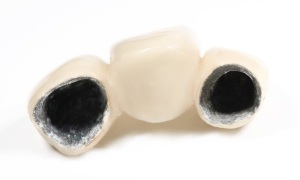 If minor destructive changes can be stopped using medicinal pastes and rinses, a significant loss of enamel implies the use of more radical methods.
If minor destructive changes can be stopped using medicinal pastes and rinses, a significant loss of enamel implies the use of more radical methods.
These are already mentioned veneers, sealing with the use of light-cured fillings.
If the tooth has crumbled more than half, installation of crowns is shown.
If the tooth crumbles and the root remains alive
When the tooth enamel is completely crumbled, the only option for its restoration is prosthetics. The living root of the tooth is subject to depulpation, since leaving the neuromuscular bundle under the crown can cause a serious inflammatory process.
The professor reveals all the secrets about cracks and other damage to the teeth and the solution of this problem - a cognitive video:
To prevent such a problem as a tooth fracture, breaking the ideal smile line, it is important to constantly strengthen the tooth enamel, daily use for cleaning not only the brush,but the thread at least twice after eating.
Once a year, you need to sanitize the oral cavity in the dentist's office. In addition, rinsing the oral cavity with clean water after acidic dishes and drinks, which it is desirable to use through a straw to ensure a minimum contact with the teeth.
Replace rinses after eating can be a chewing gum that stimulates the production of saliva.
